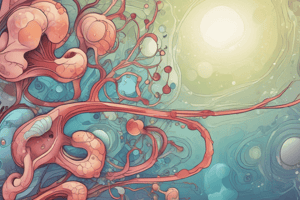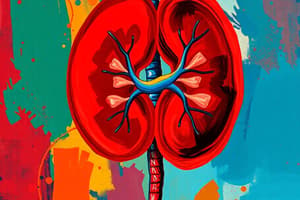Podcast
Questions and Answers
What is the condition of the nephrons in the affected area?
What is the condition of the nephrons in the affected area?
- They are damaged and have a low filtration rate (correct)
- They are functioning normally
- They are inflamed and have a high filtration rate
- They are infected and have a normal filtration rate
What can be observed in venous plasma from the affected nephrons?
What can be observed in venous plasma from the affected nephrons?
- A decrease in filtration rate (correct)
- A normal filtration rate
- An irregular filtration rate
- An increase in filtration rate
Where are the proximal convoluted tubules located?
Where are the proximal convoluted tubules located?
- In the medulla of the kidney
- In the renal pelvis
- In the ureter
- In the cortex of the kidney (correct)
What is NOT located in the cortex of the kidney?
What is NOT located in the cortex of the kidney?
What is the condition of the tubular function in the affected nephrons?
What is the condition of the tubular function in the affected nephrons?
Where are the glomeruli located?
Where are the glomeruli located?
What happens to an ion when it undergoes symmetric transport?
What happens to an ion when it undergoes symmetric transport?
What is the result of the decreased filtration rate in the affected nephrons?
What is the result of the decreased filtration rate in the affected nephrons?
What is the term for the decreased filtration rate in the affected nephrons?
What is the term for the decreased filtration rate in the affected nephrons?
What is the result of symmetric transport on an ion's charge?
What is the result of symmetric transport on an ion's charge?
What is the main function of the proximal convoluted tubules?
What is the main function of the proximal convoluted tubules?
Where do the distal convoluted tubules empty?
Where do the distal convoluted tubules empty?
What type of charge does an ion acquire after symmetric transport?
What type of charge does an ion acquire after symmetric transport?
What is the effect of symmetric transport on an ion's charge?
What is the effect of symmetric transport on an ion's charge?
What happens to the charge of an ion when it undergoes symmetric transport?
What happens to the charge of an ion when it undergoes symmetric transport?
What is the term for obstruction that occurs within the kidney?
What is the term for obstruction that occurs within the kidney?
What is the term for obstruction that occurs outside the kidney?
What is the term for obstruction that occurs outside the kidney?
What is a possible cause of acute kidney injury?
What is a possible cause of acute kidney injury?
What is a complication of rhabdomyolysis?
What is a complication of rhabdomyolysis?
What is a complication of sepsis?
What is a complication of sepsis?
What is the term for raised nitrogen concentration?
What is the term for raised nitrogen concentration?
What is NOT a term for raised nitrogen concentration?
What is NOT a term for raised nitrogen concentration?
What is opposite of oliguria?
What is opposite of oliguria?
What is a condition characterized by the excretion of glucose in the urine?
What is a condition characterized by the excretion of glucose in the urine?
What is a term that refers to an abnormally low urine output?
What is a term that refers to an abnormally low urine output?
Flashcards are hidden until you start studying
Study Notes
Kidney-Related Terms
- Uraemia refers to raised nitrogen concentration in the blood.
- Azotemia is another term for raised nitrogen concentration in the blood.
- Hyperkalemia refers to high levels of potassium in the blood.
- Glycosuria refers to the presence of glucose in urine.
- Oliguria refers to a decrease in urine volume.
Electrolyte Transport
- Transport of one ion can lead to the movement of another ion with an opposite charge.
Kidney Structure and Function
- The proximal convoluted tubules, distal convoluted tubules, and collecting ducts are all located in the cortex of the kidney.
- Glomeruli are not located in the cortex of the kidney.
Kidney Function and Obstruction
- Intrarenal obstruction occurs within the kidney, whereas extrarenal obstruction occurs outside the kidney.
- Prolonged renal circulatory insufficiency, septicaemia, and myoglobulinuria are all conditions that can affect kidney function.
- In cases of intrarenal obstruction, venous plasma from affected nephrons may show decreased glomerular filtration rate with normal tubular function.
Studying That Suits You
Use AI to generate personalized quizzes and flashcards to suit your learning preferences.




